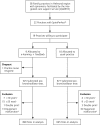Effect of e-learning and repeated performance feedback on spirometry test quality in family practice: a cluster trial
- PMID: 21747104
- PMCID: PMC3133580
- DOI: 10.1370/afm.1258
Effect of e-learning and repeated performance feedback on spirometry test quality in family practice: a cluster trial
Abstract
Purpose: Spirometry has become an indispensable tool in primary care to exclude, diagnose, and monitor chronic respiratory conditions, but the quality of spirometry tests in family practices is a reason for concern. Aim of this study was to investigate whether a combination of e-learning and bimonthly performance feedback would improve spirometry test quality in family practices in the course of 1 year.
Methods: Our study was a cluster trial with 19 family practices allocated to intervention or control conditions through minimization. Intervention consisted of e-learning and bimonthly feedback reports to practice nurses. Control practices received only the joint baseline workshop. Spirometry quality was assessed by independent lung function technicians. Two outcomes were defined, with the difference between rates of tests with 2 acceptable and repeatable blows being the primary outcome and the difference between rates of tests with 2 acceptable blows being the secondary outcome. We used multilevel logistic regression analysis to calculate odds ratios (ORs) for an adequate test in intervention group practices.
Results: We analyzed 1,135 tests. Rate of adequate tests was 33% in intervention and 30% in control group practices (OR = 1.3; P=.605). Adequacy of tests did not differ between groups but tended to increase with time: OR = 2.2 (P = .057) after 3 and OR = 2.0 (P = .086) in intervention group practices after 4 feedback reports. When ignoring test repeatability, these differences between the groups were slightly more pronounced: OR = 2.4 (P = .033) after 3 and OR=2.2 (P = .051) after 4 feedback reports.
Conclusions: In the course of 1 year, we observed a small and late effect of e-learning and repeated feedback on the quality of spirometry as performed by family practice nurses. This intervention does not seem to compensate the lack of rigorous training and experience in performing spirometry tests in most practices.
Figures



References
-
- Walker PP, Mitchell P, Diamantea F, Warburton CJ, Davies L. Effect of primary-care spirometry on the diagnosis and management of COPD. Eur Respir J. 2006;28(5):945–952. - PubMed
-
- Yawn BP, Enright PL, Lemanske RF Jr, et al. Spirometry can be done in family physicians’ offices and alters clinical decisions in management of asthma and COPD. Chest. 2007;132(4):1162–1168. - PubMed
Publication types
MeSH terms
LinkOut - more resources
Full Text Sources
